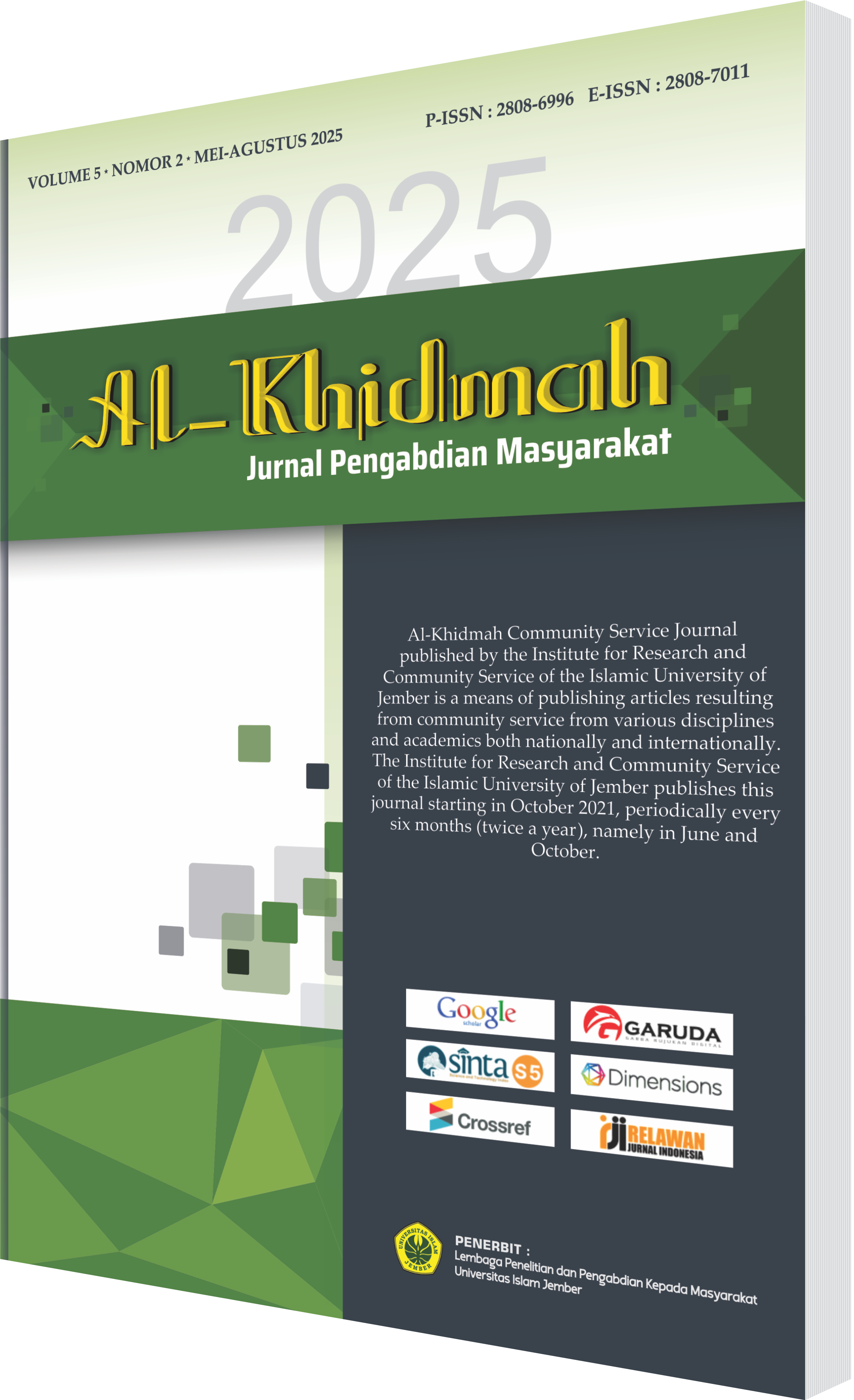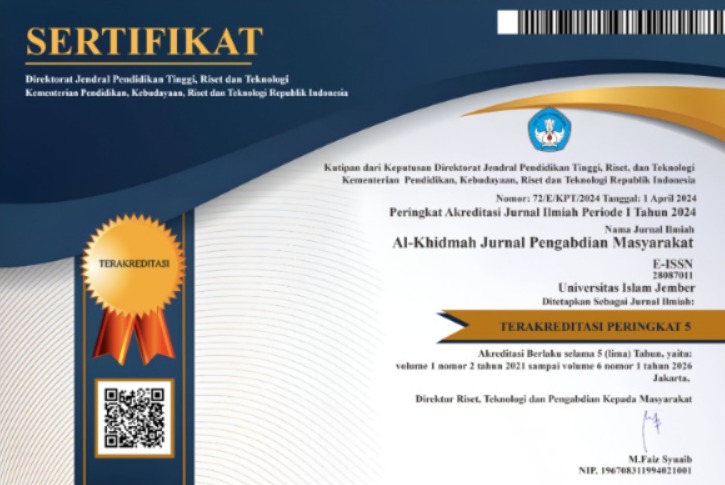Program Penanganan Kucing liar di Sekitar Wilayah Kampus Sunan Giri Surabaya
DOI:
https://doi.org/10.56013/jak.v5i2.4186Keywords:
Stray cats; community service; sterilization; education; animal-friendly campusAbstract
The existence of stray cats in the Sunan Giri Surabaya Campus environment has caused a number of problems, both in terms of hygiene, comfort, and potential public health risks due to zoonotic diseases. In response to this, this community service activity is designed to provide solutions based on education, medical measures (sterilization), and the active involvement of the campus community in the ethical and sustainable management of feral cat populations. The methods used include initial observation of the cat population, education through seminars and campaign media, the implementation of the Trap-Neuter-Return (TNR) program for 14 cats, and the construction of four feeding stations as feeding and monitoring points. This activity also involves the formation of student volunteer groups as a driver of program sustainability. The results of the activities show significant changes, including a decrease in the number of stray cats that roam aimlessly, an increase in the awareness of the academic community on the importance of humane animal management, and the creation of a cleaner and more comfortable campus environment. This program is proof that a collaborative and educational approach can create solutions that not only solve technical problems, but also build a broader culture of care in the college environment.
References
Andrew Kurniawan Vadreas, Dwi Welly Sukma Nirad, Husni Wenti. (2020). “Web based Expert System dalam Penanganan Kesehatan dan Penyakit Kucing di Kota Padang.” Jurnal Sisfokom (Sistem Informasi dan Komputer) 9 (1): 20–29. https://doi.org/10.32736/sisfokom.v9i1.677.
Ario, Anton. (2010). Panduan Lapangan Kucing-kucing liar Indonesia. Pertama. Jakarta: yayasan Pustaka Obor Indonesia. https://books.google.co.id/books?hl=id&lr=&id=sfPoDQAAQBAJ&oi=fnd&pg=PP1&dq=Keberadaan+kucing+liar++&ots=LkygkupGzF&sig=u6uv6J6rDNDxJvT8SOwD72VJprI&redir_esc=y#v=onepage&q=Keberadaan kucing liar&f=false.
Dinda, Aulia. (2022). Perancangan Buku Ilustrasi Tradisi Mappasili Sebagai Upaya Pelestarian Budaya Masyarakat Bugis-Makassar Media saat ini telah berkembang pesat dari waktu ke waktu , salah satunya adalah media yang dapat memuat informasi kesehatan . Pemilihan media untuk” x.
Dwi, A. Prayuani. (2015). “Kejadian Toksoplasmosis Pada Pemelihara Dan Bukan Pemelihara Kucing Di Kecamatan Mulyorejo , Surabaya. Kesehatan Lingkungan, 103–17.
Dwi, Lailia, Kusuma Wardhani, Nicodemos Borges Lonai, Era Hari, Mudji Restijono, dan Fakultas Kedokteran Hewan. (2019). Jurnal Vitek Bidang Kedokteran Hewan Vol . 9 , November 2019 Derajat Kesehatan Kucing Liar ( Felis Catus ) Melalui Pemeriksaan Fungsi Liver ( Sgpt And Sgot ) Di Pasar Kecamatan” 9 (November): 6–9.
Evelina, Cecilia, dan Nina Carina. (2021). Fasilitas Penanganan Hewan Terlantar Manusia , hewan , dan tumbuhan dalam ekologi adalah makhluk yang setara . Semua unsur dalam terutama hewan peliharaan , dalam menjaga kesehatan mental dan tubuh manusia . Bermain dengan masyarakat kota tidak lagi dapat” 3 (2): 2223–36. https://doi.org/10.24912/stupa.v3i2.12378.
Fikri, Muh, Indra Riyanti, Muslimah Fitrah, dan Syarif Hidayat Amrullah. (2024). “Perilaku Harian Kucing Domestik Liar di Lingkungan Garaganti Kabupaten Perilaku Harian Kucing Domestik Liar di Lingkungan Garaganti Kabupaten Gowa,” no. October. https://doi.org/10.13140/RG.2.2.25771.86569.
Hanif, Abdurrahman, Tulus Dharmawan, dan Amri Siddi Pangestu. (2017). “Catstrate : Solusi Menekan Ledakan Populasi Kucing Lokal.” Animal Walfare and Sustainable Community, no. October: 0–3.
Hartuti, Reza Sofa, Mulyadi Adam, dan Triva Murtina. (2013). Beberapa Pet Shop Di Wilayah Bekasi , Jawa Barat. Jurnal Medika Veterinaria 8 (1): 37–42.
Ifa Gerhanawati, Ken Siwi, S Ftr, M Biomed, dan Ridho Syahid Effendi. 2023. “Laporan pengabdian,” no. 59.
Prisca, Hannah. (2019). “Perancangan Program Kampanye Rescue and Adopt Melalui Webtoon Four Little Feet Untuk Membangun Sikap Kepedulian Pada Hewan.” Journal of Servite 1 (1): 50. https://doi.org/10.37535/102001120195.
Taufiq Hidayat, Muhammad. (2024). “Manajemen Populasi Kucing Liar Melalui Collaborative Filtering Untuk Kesehatan Dan Ekosistem Lokal.” INDEXIA : Informatic and Computational Intelligent Journal 06 (1): 12–21.
Downloads
Published
How to Cite
Issue
Section
License
Copyright (c) 2025 Haniyah Haniyah, Bilqisthi Ari Putra, Abdul Quddus Salam, Balqis Ria Putri, Atmari Atmari

This work is licensed under a Creative Commons Attribution-ShareAlike 4.0 International License.






